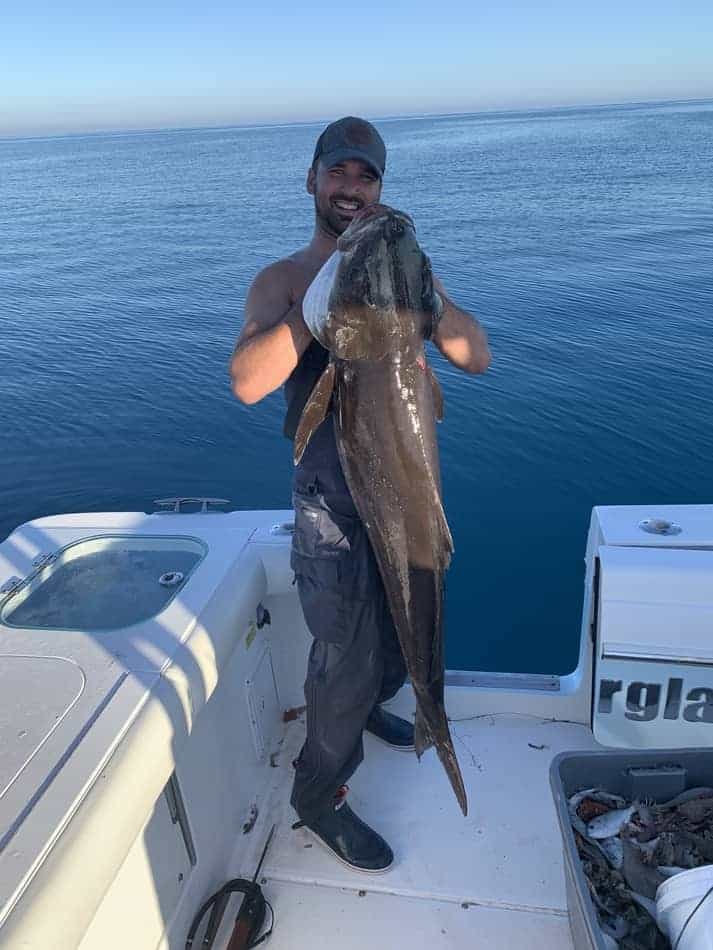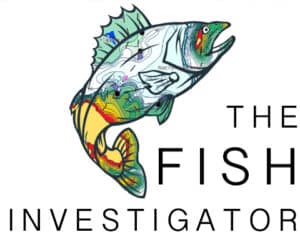
Cobia are one of the strongest inshore fish, which is why so many anglers have Cobia on the top of their favorite fish to catch list. Let’s talk about how to catch Cobia by looking at where to find them, what they eat, and the best methods to target them.
How To Catch Cobia
The best way to catch Cobia is sight fishing using eel or crab as bait. Cobia are known to congregate heavily in 15 feet to 50 feet of water, often following rays, turtles, and sharks.
Bottom fishing and sight fishing are the most popular methods to target Cobia; let’s dive into the details.
Sight Fishing Cobia
By far, the most popular method for catching Cobia is sight fishing. Cobia are migratory fish that are often found inhabiting the upper columns of water where they follow large sea animals, including rays, turtles, whales, and sharks.
While targeting Cobia, it is best to get as high as possible on your boat for a vantage point that will help you locate these fish. Most of the time, you will be able to locate the sea creatures that cobia follow. Rays and turtles often look like brown squares of cardboard floating a couple of feet below the surface, where whales and sharks often look blue in color and tend to stay lower in the water column. Cobia can be spotted themselves without the help of other sea creatures by looking for long purple to greenish shadows.
Once you locate a school of Cobia, slowly approach the fish but keep your distance, so you do not spook them off. When you are in casting distance, toss live bait 4’ to 5’ away from them and slowly drag it by the school. Once your bait is directly in front of the school, allow your bait to sink slowly, this is when most Cobia will hit your bait. Crab and eel are the most popular baits to target these fish, with the eel being the most productive.
Here Are My Top 7 Fishing Tips to Catch Cobia
- Find floating structures: Structures including wood, sargassum weeds, or the occasional capsized boat in 15’ to 300’ of water are a great opportunity to hook up to a large Cobia. Large Cobia are known to congregate around floating structures, especially in nearshore waters
- Check the water temperature: Cobia are migratory fish often moving north and south in search of ideal water temperatures. While targeting Cobia, you will want warmer water temperatures exceeding 68 degrees Fahrenheit. Anything lower than 68 degrees will make it much harder to catch Cobia.
- Take advantage of their curiosity: Cobia are one of the most curious fish in the ocean. You will find that Cobia will often swim directly to your boat the moment you pull up to wreck or other bottom structures. As soon as they surface, you better be ready to toss a bait their way.
- Fish clear waters: Cobia are known to prefer areas with clear waters over murky waters. When looking for Cobia, make sure to get out a couple of yards offshore, where waters tend to be higher in salinity and clearer overall.
- Be prepared to present multiple options: Cobia can be picky eaters, so be prepared to toss multiple options their way. Sometimes Cobia will not be interested in one bait, but they devour something different. I always try to bring three live bait options when targeting Cobia, including American eels, crabs, and shrimp.
- Bring chum: One of the fastest ways to attract Cobia, especially if you target them on some form of structure, is to get a chum block in the water. I have personally witnessed a school of Cobia surface from a wreck within seconds after throwing a block of chum in the water. They proceeded to start chewing at my chum bag.
- Bring your polarized glasses: When targeting Cobia, it is essential to bring your polarized glasses to assist you in locating Cobia. Cobia often blend into the colors of the water, especially during mornings and late afternoons when the glare on the water is at its peak. A good pair of polarized glasses will dramatically increase your chances of locating more fish.
When polled, 91% of fishing captains stated that the best fishing depth to catch Cobia was between 30 and 50 feet in depth
Independent poll by fishinvestigator.com
When Can You Catch Cobia?
Cobia are caught throughout the year in tropical waters but are most prevalent during the spring and summer months when water temperatures exceed 68 degrees Fahrenheit. The Cobia bite is strongest at dawn and dusk but is often targeted at noon when Cobia is easiest to see.
Where Do You Catch Cobia?
Cobia are caught in tropical, subtropical, & temperate waters around the world. Cobia are caught in waters less than 300’ in-depth, with 15’ to 50’ being the most active depth to target them. Cobia prefer congregating around structures both floating & submerged.
Top Fishing Structures to Target Cobia
- Wrecks
- Rock piles
- Pilings
- Buoys
- Sargassum weed lines
- Bridges
- Navigational markers
- Floating debris
Natural Cobia Diet
- Shrimp
- American Eels
- Batfish (varying species)
- Crabs
- Blue Runner
- Squid
Best Fishing Tackle For Cobia
When it comes to catching Cobia, using the correct fishing tackle will dramatically increase the amount of fish you will catch.
Best Fishing Rod For Cobia
Cobia are most often caught sight fishing, so using a 7’ to 7’6″ spinning rod is ideal for making a long cast to surface-dwelling Cobia. Cobia are powerful fighting fish so choosing a medium to a medium-heavy fishing rod is ideal.
I have always loved fishing with Shimanos Trevala with medium-heavy power. This rod is rated for a maximum of 50lb braid, ideal for targeting big Cobia.
Best Fishing Reel For Cobia
When it comes to catching Cobia, choosing a reel with a strong drag and large line capacity is ideal. I have always fished a 5000-6000 sized reel when targeting Cobia.
Shimano TwinPower in the 5000 size has always been a great reel to target Cobia. The reel has 29lb of drag and the line capacity for 225 yards of 30lb braid.
Best Line To Use For Cobia
When fishing for Cobia, use a strong braid ranging from 25lb to 40lb test. Using braid will increase your overall casting distance, which is essential when sight fishing Cobia. Also, braided line will increase your reel’s overall line capacity, which will lessen the chances of monster Cobia completely spooling your reel.
What size Leader To Use For Cobia
When fishing for Cobia, the ideal leader size is a 40lb test. Cobia are extremely strong fish, so a heavy leader size is a must to limit the number of break-offs. Also, Cobia have extremely good eyesight so it is important to use 100% fluorocarbon leader to ensure that the Cobia cannot see your leader.
What Size Hooks For Cobia?
The ideal hook size for Cobia is a 6/0 but varies from 5/0 to 8/0 depending on the size of the Cobia you are targeting.
Let’s take a deeper look at how to catch Cobia by learning more about the species as a whole.
What are Cobia?
Rachycentron Canadum, often referred to as Cobia, Ling, Lemonfish, Black Bonito, Striped Cat, and my favorite “man in the brown suit,” is a gamefish often caught in tropical, subtropical, and temperate waters. Cobia are known to grow to extreme sizes and have been caught weighing in over 100lbs.
Cobia are a dark brown color and slowly fade to lighter shades towards their belly. Cobia’s bodies are elongated and have a wide head with a flattened appearance. Cobia have large mouths filled with villiform teeth that have the appearance of rough sandpaper.
Are Cobia Good To Eat?
Cobia are excellent at eating. The flesh of the fish is firm and flaky with a mild flavor profile, often compared to chicken.
Is Cobia High In Mercury?
According to the EPA, Cobia is extremely high in Mercury content, coming in at .683 PPM. To put that into perspective, lemon sharks, which is rarely harvested because of their high mercury levels, come in at .697
Are Cobia Toxic?
Though Cobia are high in mercury, they are not known to be toxic if consumed in small quantities.
Is Cobia Related To Remora?
Cobia and Remora are closely related, sharing a couple of physical attributes, including body shape and color.
Do Cobia Have Scales?
Cobia have extremely small scales that start from their gill plates and end at the base of their tails. Cobia feel like they have no scales because the size of their scales is so small. They feel completely smooth when handled.
Do Cobia Have Teeth?
Cobia has small villiform teeth just inside their mouths that have the texture of rough sandpaper.
